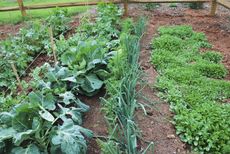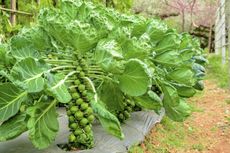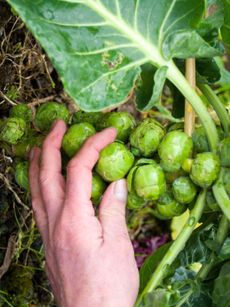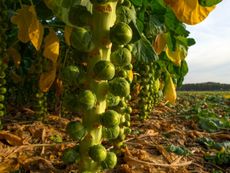Winter Care For Brussels Sprouts: How To Grow Brussels Sprouts In Winter


A member of the cabbage family, Brussels sprouts look much akin to their cousins. The sprouts look like miniature cabbages dotted up and down the 2 to 3 foot (61-91 cm.) long stems. Brussels sprouts are the hardiest of the cabbages, and in some regions, such as areas of the Pacific Northwest, growing Brussels sprouts over winter is a common practice. Do Brussels sprouts need winter protection or any other special winter care? The following article contains information about how to grow Brussels sprouts in the winter and winter care for Brussels sprouts.
How to Grow Brussels Sprouts in Winter
Brussels sprouts thrive in cooler temps, so sowing and planting them at the appropriate time is imperative. Brussels sprouts are planted later than warm-season crops, such as peppers and squash, from late fall into winter harvest. Depending upon the variety, Brussels sprouts take from three to six months to mature from seed. Start seed indoors about 16 to 20 weeks prior to the last frost in your area. Transplants are ready for the garden 12 to 14 weeks before the last frost in spring. For fall harvest, Brussels sprouts are planted in late May through early July. If you are growing Brussels sprouts over the winter in very mild areas, plant the crop in early autumn for a late winter to early spring harvest. Depending on your timing, opt for early varieties such as Prince Marvel, Jade Cross, and Lunet, which mature within 80 to 125 days from seed and are ready for harvest in the fall and early winter. In western areas of USDA zone 8, late-maturing varieties are suitable for winter growing and will be ready to harvest from December through April. These include Fortress, Stablolite, Widgeon, and Red Rubine. While Brussels sprouts can be directly sown, due to timing and weather, success is more probable if you start them indoors. Transplants should be spaced 18 to 25 inches (46-63.5 cm.) apart in rows that are 2 to 3 feet (61-91 cm.) apart in a full sun area with good drainage, fertile soil, and high in calcium with a pH around 5.5 to 6.8. Be sure to practice crop rotation to minimize the incidence of disease. Do not plant in the same area as other cabbage members in the previous three years. Since Brussels sprouts have shallow roots and top-heavy heads, provide some sort of support or staking system for them. Brussels sprouts are heavy feeders and should be fertilized at least two times during the growing season. The first time is when they are first planted. Fertilize with a high phosphorus food. Apply a second dose of fertilizer that is rich in nitrogen several weeks after. High nitrogen foods include liquid fish emulsion, blood meal, or just a commercial fertilizer high in nitrogen.
Do Brussels Sprouts Need Winter Protection?
As mentioned, Brussels sprouts do very well in areas of the Pacific Northwest with its mild weather conditions (USDA zone 8) and can be grown in the winter. In USDA zone 8, very little winter care is required for Brussels sprouts. Brussels sprouts can also be grown in USDA zones 4 through 7 but with harsher winters, caring for Brussels sprouts in winter requires a greenhouse. They are cool-season veggies and can withstand freezes for short periods of time, but sustained cold snaps and burial in the snow won’t result in winter sprouts. In colder climates, Brussels sprout plants should be pulled out of the soil before temps drop below 10 degrees F. (-12 C.) in the late fall. They can then be stored in a cool, dry area with their roots buried in a box of damp sand. In milder areas, where temperatures rarely dip below freezing for an extended period of time, caring for Brussels sprouts in winter requires little effort. My neighbor here in the Pacific Northwest simply rakes up everything in her yard in the fall and mulches around the plants with the fall leaves. So far, she has had beautiful standing plants with fresh Brussels sprouts ready for harvest during the winter holidays.
Gardening tips, videos, info and more delivered right to your inbox!
Sign up for the Gardening Know How newsletter today and receive a free download of our most popular eBook "How to Grow Delicious Tomatoes."

Amy Grant has been gardening for 30 years and writing for 15. A professional chef and caterer, Amy's area of expertise is culinary gardening.
-
 26 Different Types Of Orchids – With Pictures & Information
26 Different Types Of Orchids – With Pictures & InformationDiscover stunning orchid types to grow in your home and garden – from easy beginner varieties to rare and exotic species that are the preserve of experts.
By Melanie Griffiths
-
 Urban Composting Guide: How To Compost In The Middle Of The City
Urban Composting Guide: How To Compost In The Middle Of The CityUrban composting does not have to be daunting. You can compost in the city, and maybe even try some urban worm composting!
By Mary Ellen Ellis
-
 Reasons For No Brussels Sprouts On Plants
Reasons For No Brussels Sprouts On PlantsBrussels sprouts are a healthy superfood in the garden. Learn why they sometimes don’t produce properly.
By Laura Miller
-
 My Brussels Sprout Plants Bolted: Reasons Why Brussels Sprouts Are Bolting
My Brussels Sprout Plants Bolted: Reasons Why Brussels Sprouts Are BoltingYou carefully tend and care for them then one day your brussels sprouts are bolting. It's frustrating. Learn about brussels sprouts bolting here.
By Laura Miller
-
 Brussels Sprouts Companion Plants – What To Grow With Brussels Sprouts
Brussels Sprouts Companion Plants – What To Grow With Brussels SproutsThe downside of planting cruciferous relatives with Brussels sprouts is that they also share similar pests and diseases. Are there other Brussels sprout companion plants that might be a better choice? Click this article to find out.
By Amy Grant
-
 Pruning Brussels Sprouts: When To Prune Leaves Of Brussels Sprouts
Pruning Brussels Sprouts: When To Prune Leaves Of Brussels SproutsBrussels sprouts, it seems you either love them or hate them. If this is your first time growing your own, you might be wondering how to trim Brussels sprout plants or do you even have to trim Brussels sprouts? Learn more in this article.
By Amy Grant
-
 Brussels Sprouts: Pests And Diseases Affecting Brussels Sprouts Plants
Brussels Sprouts: Pests And Diseases Affecting Brussels Sprouts PlantsBrussels sprouts resemble little cabbages, arrayed on a stiff vertical stem. The rather old-fashioned vegetable has a "love it or hate it" reputation. The gardener needs to be wary of common issues, and this article will help.
By Bonnie L. Grant
-
 Picking Brussel Sprouts: How To Harvest Brussel Sprouts
Picking Brussel Sprouts: How To Harvest Brussel SproutsHarvesting Brussels sprouts provides a nutritious side dish on the table. Learning when to harvest Brussels sprouts can make your experience more flavorful. This article will help with harvesting Brussels sprouts.
By Becca Badgett
-
 Brussels Sprout Problems: What To Do For Loose Leafed, Poorly Formed Heads
Brussels Sprout Problems: What To Do For Loose Leafed, Poorly Formed HeadsEven under the best conditions, growing Brussels sprouts is a tricky challenge for a gardener. One of the issues is when the plant has loose leafed, poorly formed heads. Learn more in this article.
By Heather Rhoades
-
 How To Grow Brussels Sprouts
How To Grow Brussels SproutsBrussels sprouts have gotten a bad rap. These miniature cabbage looking vegetables are extremely tasty if eaten freshly picked. Learn how to grow Brussels sprouts in this article so you can enjoy them too.
By Heather Rhoades